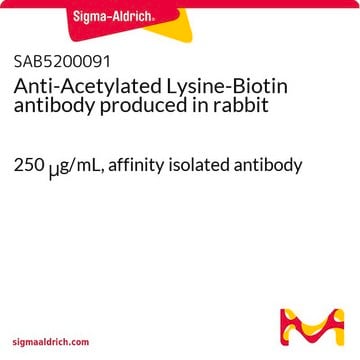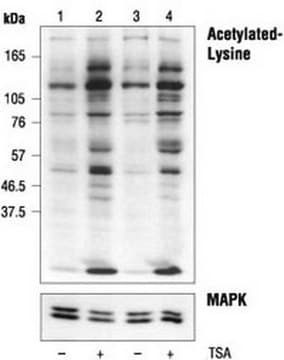05-714
Anti-Lamin A/C Antibody, clone 14
clone 14, Upstate®, from mouse
Sinonimo/i:
Anti-CDCD1, Anti-CDDC, Anti-CMD1A, Anti-CMT2B1, Anti-EMD2, Anti-FPL, Anti-FPLD, Anti-FPLD2, Anti-HGPS, Anti-IDC, Anti-LDP1, Anti-LFP, Anti-LGMD1B, Anti-LMN1, Anti-LMNC, Anti-LMNL1, Anti-MADA, Anti-PRO1
Scegli un formato
CHF 501.00
Spedizione prevista il22 maggio 2025
Scegli un formato
About This Item
CHF 501.00
Spedizione prevista il22 maggio 2025
Prodotti consigliati
Origine biologica
mouse
Livello qualitativo
Forma dell’anticorpo
purified immunoglobulin
Tipo di anticorpo
primary antibodies
Clone
14, monoclonal
Reattività contro le specie
canine, chicken, human, rat, mouse
Produttore/marchio commerciale
Upstate®
tecniche
immunocytochemistry: suitable
western blot: suitable
Isotipo
IgG
N° accesso NCBI
N° accesso UniProt
Condizioni di spedizione
dry ice
modifica post-traduzionali bersaglio
unmodified
Informazioni sul gene
human ... LMNA(4000)
Descrizione generale
Specificità
Immunogeno
Applicazioni
This antibody has been reported by an independent laboratory to detect Lamin A/C in human endothelial cells.
Cell Structure
Cytoskeletal Signaling
Qualità
Western Blot Analysis:
0.5-2 μg/mL of this antibody detected Lamin A/C in 20 μg of RIPA lysates from A431 cells.
Descrizione del bersaglio
Linkage
Stato fisico
Stoccaggio e stabilità
Risultati analitici
Positive Antigen Control: Catalog #12-301, non-stimulated A431 cell lysate. Add 2.5µL of 2-mercaptoethanol/100µL of lysate and boil for 5 minutes to reduce the preparation. Load 20µg of reduced lysate per lane for minigels.
Altre note
Note legali
Esclusione di responsabilità
Non trovi il prodotto giusto?
Prova il nostro Motore di ricerca dei prodotti.
Raccomandato
Codice della classe di stoccaggio
10 - Combustible liquids
Classe di pericolosità dell'acqua (WGK)
WGK 1
Certificati d'analisi (COA)
Cerca il Certificati d'analisi (COA) digitando il numero di lotto/batch corrispondente. I numeri di lotto o di batch sono stampati sull'etichetta dei prodotti dopo la parola ‘Lotto’ o ‘Batch’.
Possiedi già questo prodotto?
I documenti relativi ai prodotti acquistati recentemente sono disponibili nell’Archivio dei documenti.
Active Filters
Il team dei nostri ricercatori vanta grande esperienza in tutte le aree della ricerca quali Life Science, scienza dei materiali, sintesi chimica, cromatografia, discipline analitiche, ecc..
Contatta l'Assistenza Tecnica.







